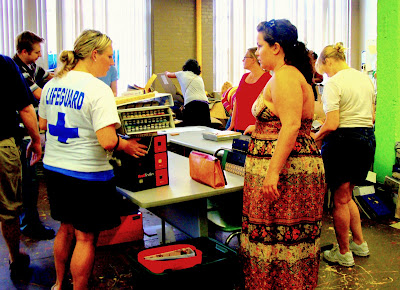For the second time this year, I attended a
Zero Landfill "harvest day", scavenging through piles of discontinued sample books, last years' fabric swatches, ceramic tiles, roofing shingles, vinyl and linoleum flooring, brightly colored rubber baseboards, multi-textured glass bock, and an infinite variety of wall paper, and carpet squares. All these items are donated by local architecture and design firms, to be recycled by artists and educators, turned into art, and kept from entering our nations' landfills.

Why do I do this?
My reasons are not all tree-hugger and environmental, as noble as those motivations might be. No, I scavenge out of necessity - me, and the scores of other Cleveland teachers digging through the piles of designer discards.
You see, the average supply budget for art teachers in the Cleveland Municipal School District is $300 for the school year. Most high school teachers have five or six art classes totaling 150-170 students. Let's do the math kids...That comes to approximately $1.76-$2.00 per student to spend on art supplies for a school year that lasts 36 weeks. And how much do you think $2.00 buys in today's economy? At the dollar store I can buy a pack of 20 pencils and two pink erasers.
Unlike suburban schools, we cannot charge parents a materials fee, in fact, we are not even supposed to ask students to bring in their own supplies.
In order to do any project beyond pencil sketching on copy paper, Cleveland art teachers most often dip into our own salaries to supplement the materials bought with the meager school budget. We haunt yard sales and the close-out aisles at Marc's. Some teachers have even been known to dig clay out of creek beds so students could learn how to make ceramics. We also write grants and beg for donations. This has been the situation district-wide for approximately the past six years due to a shrinking tax base, competition with charter schools, cuts in state funding, and a failed levy.

Teachers are constantly encouraged to integrate math and reading into our art lessons. So in the spirit of math integration, I submit this simple problem. There are 140 visual arts teachers in the Cleveland Municipal School District, if each teacher gets $300 to buy art supplies each year, how much money does the district spend annually on art supplies for approximately 23,000 students who take visual art in a given year?
The answer is: $42,000 .
Keep in mind the dollar amount is approximate - some principals are more generous with their buildings' discretionary funds, and others are very stingy and will divide a few hundred dollars up between visual art and music classes, since they both fall under the Fine Arts Department description - but I guarantee it is not that far off.
The district claims to support the arts, but it seems to me those claims are mostly lip service. I wish that they would finally put some money where their mouth is.
How about this idea? Hire one less consultant and double the money for art supplies. Eliminate an administrator, and triple the art supply budget. Then maybe our students could have an arts experience comparable to the kids in the suburbs.
The community has complained long and loud about tax dollars that never seem to reach the classroom to directly impact students. From the front lines of the education battle field, today I add my voice.








5 comments:
MB -
In the light of the remarkable paydays that the professional athletes enjoy, not to mention the commercial $$ surrounding the R&R Hall of Fame events, the conditions that you and your fellow teachers endure is appalling!
Here's a thought: (LeBron, are you paying attention?) TAX THE WEALTHY!
Those athletes and celebrities give their "speaking engagments" and "athletic work shops" to school kids, then bask in the ego-inflating praises of their so-called "community spirit", while getting a big tax write-off for their charitable contribution...
How about this - each and every person employed by a sports or entertainment franchise could donate 100% of their pay from one home event and one away event directly to the inner-city schools....
God Bless all you inner city teachers for your commitment and hard work in the face of so very much adversity. You all exemplify the Spirit of The Warrior: strength with compassion, suffering with dignity, and endurance with confidence.
And to think you don't even have uniforms!
MB~
Since early summer, the ZeroLandfill program has distributed a weekly average total of 2.5 tons of materials to the arts education and artist community in Cleveland, Boston, and Cincinnati. Other markets are being brought online now including Akron, Louisville, Columbus, Toledo, and Minneapolis.
We rely on word of mouth and viral marketing (such as Street Smarts)
to promote our service in each community.
The supply of architectural samples is steady and we are looking at expanding into other categories such as specialty paper samples. A permanent year-round solution in Cleveland and other markets is also under consideration, contingent on funding.
Thank you for participating this year. Our hope is we can continue to connect viable material streams to audiences who place value in them as efficiently as possible. So the pressure on the pocket of artists and educators (and local landfills) can be eased just a bit.
Best Regards,
The ZeroLandfill project team
I do want to thank Zero Landfill again for all their efforts. This last visit, I found it was much easier to find items and the selection has really grown.
I took an interesting pile of large ceramic tiles for my students to use in class. I am considering using the materials I've scrounged for my advanced art students in a lesson focused on problem solving and creative new adaptations of materials.
You all are doing a phenomenal job!
Anonymous,
Thank you so much for the supportive words.
There are many who people don't understand the challenges we teachers face, and that includes a number of those folks who work for the school board in the offices on East Sixth. I write about my experiences just to provide a more intimate perspective on the work-a-day world of urban educators.
I wish more people were listening who were in a position to make positive changes.
Anonymous seems to have a point. How is the artistic community in Cleveland? Are there other artists/teachers that feel the same pinch? Would they be willing to run for office, and effect those positive changes you mentioned? Are there any well-to-do citizens there who are not in government?
Post a Comment